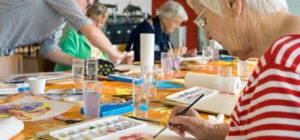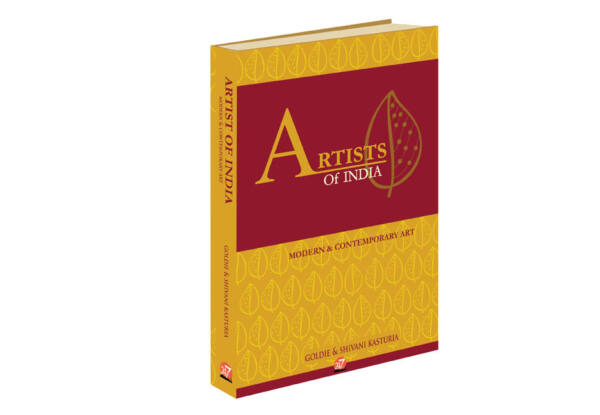In psychology, the use of artistic methods to treat psychological disorders and enhance mental health is known as art therapy. Art therapy integrates psychotherapeutic techniques with the creative process to improve mental health and well-being. It includes the creative process of art making to improve and enhance the physical, mental and emotional well-being of individuals of all ages. The creative process involved in artistic self-expression helps people to resolve conflicts and problems, develop interpersonal skills, manage behaviour, reduce stress, increase self-esteem and self-awareness, and achieve insight.
While people have been using the arts as a way to express, communicate and heal for thousands of years, art therapy only began to formalize during the middle of the 20th-century. Doctors noted that individuals suffering from mental illness often expressed themselves in drawings and other artworks, which led many to explore the use of art as a healing strategy. Since then, art has become an important part of the therapeutic field and is used in some assessment and treatment techniques.
An art therapist may use a variety of art methods including drawing, painting, sculpture and collage with clients ranging from young children to the elderly. Clients who have experienced emotional trauma, physical violence, domestic abuse, anxiety, depression and other psychological issues can benefit from expressing themselves creatively. Hospitals, private mental health offices, schools and community organizations are all possible settings where art therapy services may be available.
“In most art therapy sessions, the focus is on your inner experience—your feelings, perceptions, and imagination. While art therapy may involve learning skills or art techniques, the emphasis is generally first on developing and expressing images that come from inside the person, rather than those he or she sees in the outside world,” explains Cathy Maldiochi in The Art Therapy Sourcebook . “And while some traditional art classes may ask you to paint or draw from your imagination, in art therapy, your inner world of images, feelings, thoughts, and ideas are always of primary importance to the experience.”
An art therapist may use a variety of art methods including drawing, painting, sculpture and collage with clients ranging from young children to the elderly. Clients who have experienced emotional trauma, physical violence, domestic abuse, anxiety, depression and other psychological issues can benefit from expressing themselves creatively. Hospitals, private mental health offices, schools and community organizations are all possible settings where art therapy services may be available.
“In most art therapy sessions, the focus is on your inner experience—your feelings, perceptions, and imagination. While art therapy may involve learning skills or art techniques, the emphasis is generally first on developing and expressing images that come from inside the person, rather than those he or she sees in the outside world,” explains Cathy Maldiochi in The Art Therapy Sourcebook . “And while some traditional art classes may ask you to paint or draw from your imagination, in art therapy, your inner world of images, feelings, thoughts, and ideas are always of primary importance to the experience.”
Any form of art, whether it is music, literature, art or theatre, requires exploration and expression. They are the perfect outlet for experimentation which helps a person attain or maintain balance. They assist a person in defining parameters of his capabilities: physical, emotional, mental, and spiritual. One can analyze or read one’s feelings hidden in the strokes of a painting or strings of music. The smooth strokes can reflect the mind at ease and the haphazard strokes can make one see the restlessness or agitated state of mind. It motivates a person to discover or realize more distinctively feelings and thoughts previously vague and hidden in them, by giving them genuine means of expression; the internal pressure leading to risky behaviour may be reduced. Listening, performing, creating, and sharing are aspects that can be of assistance to people at risk become aware of how their world makes sense to themselves and how others view the sense that they are making. A form of expression different from daily activities may offer escape from inhibitions and defense mechanisms profoundly imbedded in customary expressive styles. The arts are a medium that can help those in needs accomplish better equilibrium and stability and they are a means that help each of us attain greater fulfillment.
Malchiodi says, “Art therapy asks you to explore your inner experience—your feelings, perceptions and imagination. While art therapy may involve learning skills or art techniques, the emphasis is generally first on developing and expressing images that come from inside the person, rather than those he or she sees in the outside world.”1
Games are a diversion, escape and entertainment for everyone. Though one has to keep in mind when choosing a game or puzzle, that it does not frustrate the person. It is also important to choose games, puzzles and other activities that are appropriate for adults. Card games are enjoyed by people of all ages and are considered as one of the main mind-engaging activities. Playing cards with large printed numbers makes it easy for seniors to play despite vision problem. Many senior citizens experience medical problems and illnesses that make taking part in favorite games, hobbies or activities difficult. They may have difficulty with mobility, limited dexterity or reduced vision. Their mental capacities may be affected by cognitive decline resulting from illness or disease such Alzheimer. By adapting activities and games to the needs of their limitations, many of them are able to enjoy the health and social benefits of staying active. Mental stimulation that keeps the mind fit and challenged, reestablishing appreciation skills, enhancing the memory, a healthier and longer life, social interaction and friendships, lower rates of negativity and depression, a reduction in muscle and joint pain are a few benefits of keeping oneself busy in mind-diverting activities. One can play Jigsaw puzzles, Sudoku, Boggle, Word Target, Uno, Solitaire, Hearts, and Chess Challenge etc. Internet also has many possibilities of numerous games even for blind, visually impaired or has low vision. Knitting, crocheting, gardening, scrabble, finger painting, clay modelling, mosaic etc can also keep the minds at rest and give a creative and evolved feeling. Understanding what works, combined with a love of creativity, and a desire to care for people from all walks of life are the only pre-requisites to be able to help the elderly express their unique personhood through artistic self-expression. The emphasis of art therapy is on the process of creation, that making an image, whether in pictures or words, expresses something of the person. Self-expression raises self-esteem and enables individuals with various kinds of memory loss to express their feelings.
Art therapy is no longer an adjunct to psychotherapy but is becoming important in enabling those living with various kinds of dementia to remain creative. Whereas spoken words “slip away”, paintings and poems remain as tangible objects to be found again and again. “When words are failing and the brain no longer allows the hand to create the strokes it wishes, the manipulation of miniatures – figurines of people and objects in the world – may permit a kind of sculpture or installation to be produced. This may be done in a tray of sand (the sand facilitates the positioning of figures as well as brings something from the natural world indoors). Stones and shells, seeds and flowers, leaves and bowls of water, all provide connections with nature. The joy and interest, which objects produce in those in the middle and later stages of dementia, would seem to indicate that this is not experienced as treating them like children.” 2
At a brainstorming forum “Creative expression and dementia care” held at the University of Wisconsin, Milwaukee, in November, 2006, 3 some of the leading American researchers in the field of creativity and dementia acknowledged that the benefit of creative enterprises – whether dance or music, writing or art – to people with various kinds of dementia was seriously under-researched. Yet the practitioners of the diverse creative activities present insisted on the benefits of being creative to individuals in all stages of dementia. They created a fascinating list of some of the potential outcomes positive emotional responses, reduction in agitation, greater social engagement/interaction, change in cognitive processes, increased verbal fluency, functional improvements, increased food intake, weight gain, increased mobility, greater physical strength and balance, improved mood and attention span, less stress (caregivers and receivers alike), elevated quality of life, greater understanding of the human condition.
Games are a diversion, escape and entertainment for everyone. Though one has to keep in mind when choosing a game or puzzle, that it does not frustrate the person. It is also important to choose games, puzzles and other activities that are appropriate for adults. Card games are enjoyed by people of all ages and are considered as one of the main mind-engaging activities. Playing cards with large printed numbers makes it easy for seniors to play despite vision problem. Many senior citizens experience medical problems and illnesses that make taking part in favorite games, hobbies or activities difficult. They may have difficulty with mobility, limited dexterity or reduced vision. Their mental capacities may be affected by cognitive decline resulting from illness or disease such Alzheimer. By adapting activities and games to the needs of their limitations, many of them are able to enjoy the health and social benefits of staying active. Mental stimulation that keeps the mind fit and challenged, reestablishing appreciation skills, enhancing the memory, a healthier and longer life, social interaction and friendships, lower rates of negativity and depression, a reduction in muscle and joint pain are a few benefits of keeping oneself busy in mind-diverting activities. One can play Jigsaw puzzles, Sudoku, Boggle, Word Target, Uno, Solitaire, Hearts, and Chess Challenge etc. Internet also has many possibilities of numerous games even for blind, visually impaired or has low vision. Knitting, crocheting, gardening, scrabble, finger painting, clay modelling, mosaic etc can also keep the minds at rest and give a creative and evolved feeling. Understanding what works, combined with a love of creativity, and a desire to care for people from all walks of life are the only pre-requisites to be able to help the elderly express their unique personhood through artistic self-expression. The emphasis of art therapy is on the process of creation, that making an image, whether in pictures or words, expresses something of the person. Self-expression raises self-esteem and enables individuals with various kinds of memory loss to express their feelings.
Art therapy is no longer an adjunct to psychotherapy but is becoming important in enabling those living with various kinds of dementia to remain creative. Whereas spoken words “slip away”, paintings and poems remain as tangible objects to be found again and again. “When words are failing and the brain no longer allows the hand to create the strokes it wishes, the manipulation of miniatures – figurines of people and objects in the world – may permit a kind of sculpture or installation to be produced. This may be done in a tray of sand (the sand facilitates the positioning of figures as well as brings something from the natural world indoors). Stones and shells, seeds and flowers, leaves and bowls of water, all provide connections with nature. The joy and interest, which objects produce in those in the middle and later stages of dementia, would seem to indicate that this is not experienced as treating them like children.” 2
At a brainstorming forum “Creative expression and dementia care” held at the University of Wisconsin, Milwaukee, in November, 2006, 3 some of the leading American researchers in the field of creativity and dementia acknowledged that the benefit of creative enterprises – whether dance or music, writing or art – to people with various kinds of dementia was seriously under-researched. Yet the practitioners of the diverse creative activities present insisted on the benefits of being creative to individuals in all stages of dementia. They created a fascinating list of some of the potential outcomes positive emotional responses, reduction in agitation, greater social engagement/interaction, change in cognitive processes, increased verbal fluency, functional improvements, increased food intake, weight gain, increased mobility, greater physical strength and balance, improved mood and attention span, less stress (caregivers and receivers alike), elevated quality of life, greater understanding of the human condition.
Healthy ageing is very important aspect of accepting growing up. One can avoid so many mental and physical problems with an effort to make a friend. They can choose to become a Volunteer to other people in similar conditions and find a company and get rid of melancholy. Finding support groups in the time of change is also another option. Last but not the least, creating age-friendly environment is definitely the need of the time.
REFERENCES:
1. http://psychcentral.com/blog/archives/2011/08/17/5-quick-facts-about-art-therapy/
2. Baines, Patricia, Quality Dementia Care: Nurturing the heart: Creativity, art therapy and dementia, Australian Government Initiative as part of Dementia Awareness Month September 2007, p.25
3. Ibid.,pp. 16-17
4. http://www.cecd-society.org/PDF/Pat_Baines_article-10-08-07.pdf
5. http://blog.radiantseniorliving.com/art-therapy-seniors/
1. http://psychcentral.com/blog/archives/2011/08/17/5-quick-facts-about-art-therapy/
2. Baines, Patricia, Quality Dementia Care: Nurturing the heart: Creativity, art therapy and dementia, Australian Government Initiative as part of Dementia Awareness Month September 2007, p.25
3. Ibid.,pp. 16-17
4. http://www.cecd-society.org/PDF/Pat_Baines_article-10-08-07.pdf
5. http://blog.radiantseniorliving.com/art-therapy-seniors/



